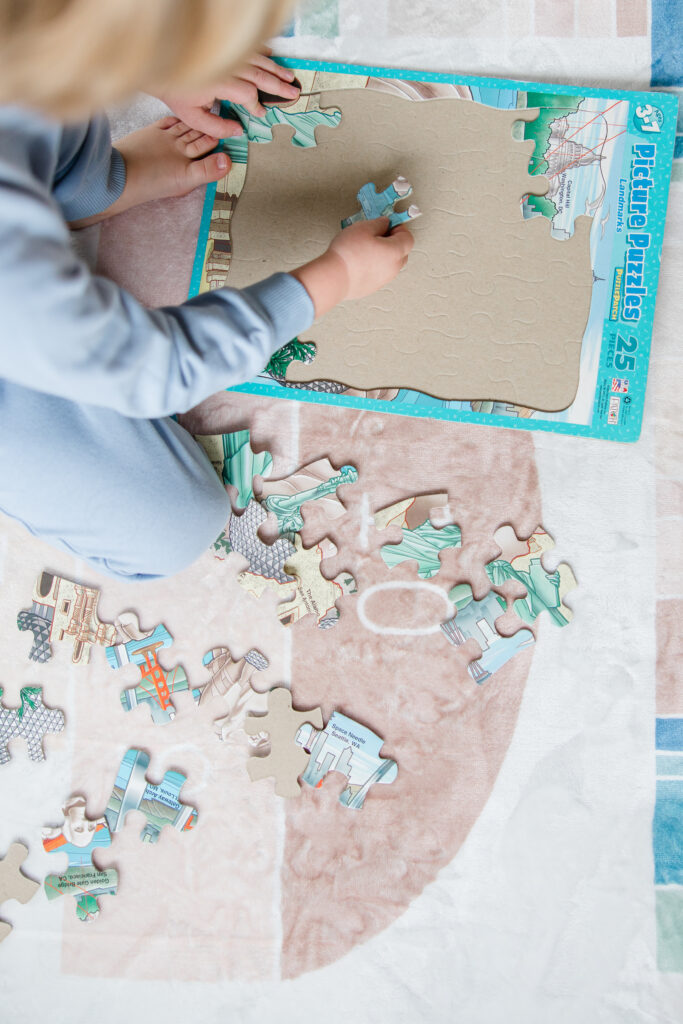How to Do Preschool at Home
Preschool at home doesn’t have to mean long lessons, expensive programs, or trying to recreate a classroom in your living room. At this age, the most important thing you can give your child is connection, play, and a love of learning.
We started preschool because honestly I felt like I didn’t really know what to do with a three-year-old, and our daughter was homeschooling so our three-year-old son was excited about it. We called it “learning time” and it quickly became my favorite part of our day.
Here are a few simple ways to make preschool at home peaceful, practical, and fun.
1. Focus on Quality One-on-One Time
Preschoolers thrive when they feel seen and connected. Set aside a short block of time each day — even just 15–20 minutes — to sit down with your child and do something intentional together.
This might look like:
- Reading a story on the couch
- Working on a puzzle together
- Doing a quick page from a workbook
The goal isn’t to finish a checklist — it’s to spend quality time where your child knows they have your full attention.
2. Use Gentle Curriculum as a Guide
You don’t need to plan out elaborate lesson plans. We’ve loved The Good and the Beautiful Pre-K because it’s open-and-go, developmentally appropriate, and easy for both parent and child.
I felt overwhelmed with the idea of coming up with an activity every day; if you love scouring Pinterest for all the things, go for it!! For us we loved to just grab the Good and the Beautiful pre-k workbook. It included little alphabet pages we could paint or color and this was perfect for learning the foundations to prep for kindergarten.
You don’t have to finish it in a certain timeframe. Think of curriculum as a guide — not a master.
3. Encourage Independent Play
Independent play is one of the most valuable “subjects” in preschool. When kids have space to explore on their own, they build creativity, problem-solving skills, and confidence.
If your child struggles to play independently, you are NOT alone!! I recommend starting with setting a timer for about 5 minutes and then slowly increasing time.
Start with a short timer and help them find something they are excited to do and then come encourage them and ask them to tell you about all the fun they had. When our son was that age he would ask for his “independent time.”
Involve Them in Everyday Tasks
One of the simplest (and most valuable) ways to teach preschoolers is by letting them be part of your daily work at home. Folding laundry, stirring muffin batter, wiping the table, or watering plants might feel small to us, but to them it’s big kid work.
These everyday tasks build fine motor skills, responsibility, and confidence. Plus, kids this age usually love helping — and when you slow down enough to include them, you’re teaching both practical skills and character.
Try Montessori-Inspired Toys and Preschool at Home Activities
You don’t need a full Montessori setup to incorporate hands-on learning. Here are some of our favorites that encourage learning and free-play.
–Magna-Tiles (game changer- we are obsessed with these.)
–Simple puzzles
–Building tracks
-Beads and pipe cleaners for fine-motor skills (this one is so cute for fall!)
-Play kitchen or pretend food sets
These kinds of toys encourage imagination, fine motor skills, and learning through play.
Get Out of the House (Yes, That Counts!)
Preschool is the perfect age to enjoy community spaces, especially if you worry how you will socialize your homeschooler. I could go down a whole rabbit trail about this misconception, but we will save that for another day.
Library storytime: builds a love of books, listening skills, and social confidence.
Nature walks: collect leaves, count bugs, talk about the seasons.
Grocery trips: let them help find colors, letters, or numbers on items.
Playground playdates: an important skill at this age is learning how to play with others, and planning playdates with friends is a perfect way to do this, and getting together with other moms is so beneficial to you on this journey!
Learning happens everywhere — you don’t need to be at a desk for your child to grow.
Keep It Simple and Joyful
If you take nothing else from this, remember: you don’t need to force preschool at home. The best learning happens through curiosity, stories, and everyday life, and your main goal at this stage should be to start fostering a LOVE for learning, and enjoy these precious years as your babies are growing into kiddos!
Want a Simple Roadmap?
If you’re just getting started and wondering what else to do before your first homeschool day, grab my free Simple Homeschool Starter Checklist. It gives you 10 simple, doable steps to feel prepared and confident — without the overwhelm.
- 👉 [Grab it HERE!]
Cheering you on,
Katelyn

Want to know how to start homeschooling? Read this blog post!

View comments
+ Leave a comment